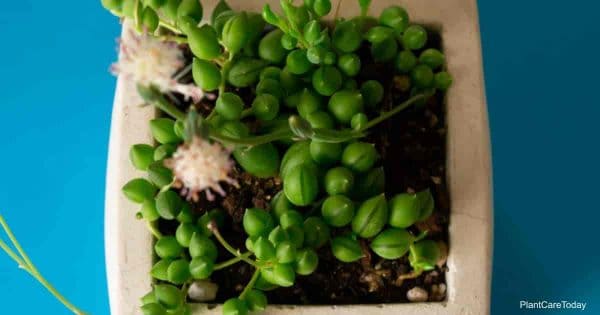Senecio rowleyanus is commonly called the String of Pearls Plant. You may also hear it referred to as String of Beads. This easy to grow, evergreen succulent presents bright green, bead shaped leaves on long, tough strings or stems.
The plant may grow outdoors as a ground cover in areas where the temperature never drops below 45° degrees Fahrenheit.

In other areas, it is grown as a houseplant in hanging baskets or other arrangements that provide it the opportunity to dangle enticingly over the sides of its container.
The long, string-like stems may grow to be three feet long and can be quite attractive to curious children and pets. This is unfortunate because the plant is rather toxic.
In this article, we discuss String of Pearls Plant toxicity and share advice on keeping and handling the plant safely. Read on to learn more.
What Parts Of The String of Pearls Are Poisonous or Toxic?
String of Beads’ vegetation and sap are slightly poisonous and should not be eaten or roughly handled. For people, the level is rated at toxicity classes 2 & 4.
What Are The Symptoms Of Pearl Plants Poisoning?
Plants rated at Class 2 level toxicity will cause symptoms such as diarrhea and can cause vomiting when ingested.
Plants rated at Class 4 level toxicity will cause rashes and other skin irritation when contact is made with the plants’ sap.
Pets and people who have consumed String of Pearl’s vegetation may exhibit symptoms such as:
- Vomiting
- Lethargy
- Drooling
- Diarrhea
Additionally, ingestion may cause skin irritation around and in the mouth.
Seek medical help right away for people or pets who may have ingested this plant.
How To Protect Yourself While Handling The String of Pearls
If you have a String of Pearls in your home or garden, take steps to pet and child proof it by placing it out of reach indoors and keep it out of reach outdoors. Pay close attention to the plant and keep its tendrils trimmed to reduce temptation.
Remember to reduce skin contact and wash your hands after pruning, repotting or otherwise handling this plant.
Choose a safer alternative. If you are just considering purchasing String of Pearls, you may want to consider similar, non-toxic succulents instead.
One good example is Sedum morganianum, also known as Burros Tail. This plant has similar requirements and growth habits but is not toxic.
[source]